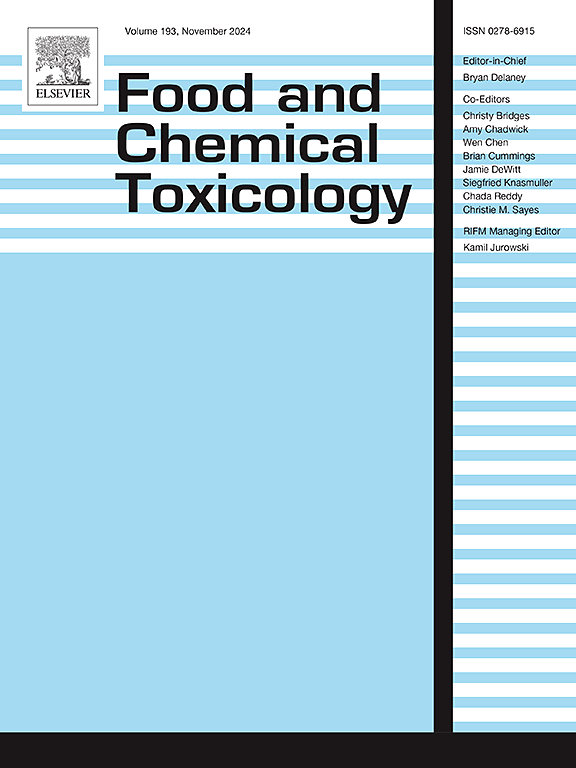Transcriptomic profiling provide insights into swainsonine-induced toxic responses and activation of the aryl hydrocarbon receptor pathway
IF 3.9
3区 医学
Q2 FOOD SCIENCE & TECHNOLOGY
引用次数: 0
Abstract
Locoweed refers to poisonous plants in the genus Oxytropis and Astragalus and distributed widely throughout the World. Foraging livestock can be poisoned through ingestion of locoweed resulting in economic loss. Swainsonine is the main toxic component of locoweed and chemically belongs to indolizidine alkaloids. The mechanism of the swainsonine-induced toxic responses is not well understood. In this study, we performed comprehensive transcriptomic analysis examining the differential gene expression in primary renal tubular epithelial cells (RTECs) of rats treated with swainsonine. Our analysis uncovered differential expressions of ncRNA(DEncRNAs) and mRNAs(DEmRNAs) in response to swainsonine treatment. Significant pathways enriched by differential genes through transcriptome association analysis were xenobiotic metabolism-cytochrome P450, bile secretion, and steroid biosynthesis, etc. Notably, aryl hydrocarbon receptor (AhR)-regulated xenobiotic pathway is significantly activated as evidenced by the coordinated up-regulation of the classic AhR-regulated battery of genes Cyp1a1, Cyp1b1, AhRR, Nqo1, and phase II enzyme Gsta2, Gsta3, Gsta5. These results suggest that swainsonine is metabolically detoxified through the AhR regulated xenobiotic detoxification pathway and furthermore, our finding also suggest an intervention strategy to ameliorate to locoweed poisoning through activation of AhR-regulated deoxification pathway.
转录组学分析提供了对马豆素诱导的毒性反应和芳烃受体途径激活的见解。
麻疯草是指麻疯草属和黄芪属的有毒植物,广泛分布在世界各地。觅食的牲畜可能因摄入马蹄莲而中毒,造成经济损失。Swainsonine是lolograss的主要毒性成分,化学上属于吲哚嘧啶类生物碱。马豆素诱导毒性反应的机制尚不清楚。在这项研究中,我们进行了全面的转录组学分析,检测了马豆素处理大鼠原发性肾小管上皮细胞(RTECs)中的差异基因表达。我们的分析揭示了ncRNA(DEncRNAs)和mrna (DEmRNAs)在马豆素治疗后的差异表达。通过转录组关联分析,差异基因富集的重要途径有外源代谢-细胞色素P450、胆汁分泌、类固醇生物合成等。值得注意的是,芳烃受体(AhR)调控的外生途径被显著激活,这可以通过AhR调控的经典基因群Cyp1a1、Cyp1b1、AhRR、Nqo1和II期酶Gsta2、Gsta3、Gsta5的协同上调来证明。这些结果表明,马豆素通过AhR调节的外源解毒途径代谢解毒,此外,我们的发现还提示了通过激活AhR调节的解毒途径来改善麻草中毒的干预策略。
本文章由计算机程序翻译,如有差异,请以英文原文为准。
求助全文
约1分钟内获得全文
求助全文
来源期刊

Food and Chemical Toxicology
工程技术-毒理学
CiteScore
10.90
自引率
4.70%
发文量
651
审稿时长
31 days
期刊介绍:
Food and Chemical Toxicology (FCT), an internationally renowned journal, that publishes original research articles and reviews on toxic effects, in animals and humans, of natural or synthetic chemicals occurring in the human environment with particular emphasis on food, drugs, and chemicals, including agricultural and industrial safety, and consumer product safety. Areas such as safety evaluation of novel foods and ingredients, biotechnologically-derived products, and nanomaterials are included in the scope of the journal. FCT also encourages submission of papers on inter-relationships between nutrition and toxicology and on in vitro techniques, particularly those fostering the 3 Rs.
The principal aim of the journal is to publish high impact, scholarly work and to serve as a multidisciplinary forum for research in toxicology. Papers submitted will be judged on the basis of scientific originality and contribution to the field, quality and subject matter. Studies should address at least one of the following:
-Adverse physiological/biochemical, or pathological changes induced by specific defined substances
-New techniques for assessing potential toxicity, including molecular biology
-Mechanisms underlying toxic phenomena
-Toxicological examinations of specific chemicals or consumer products, both those showing adverse effects and those demonstrating safety, that meet current standards of scientific acceptability.
Authors must clearly and briefly identify what novel toxic effect (s) or toxic mechanism (s) of the chemical are being reported and what their significance is in the abstract. Furthermore, sufficient doses should be included in order to provide information on NOAEL/LOAEL values.
 求助内容:
求助内容: 应助结果提醒方式:
应助结果提醒方式:


